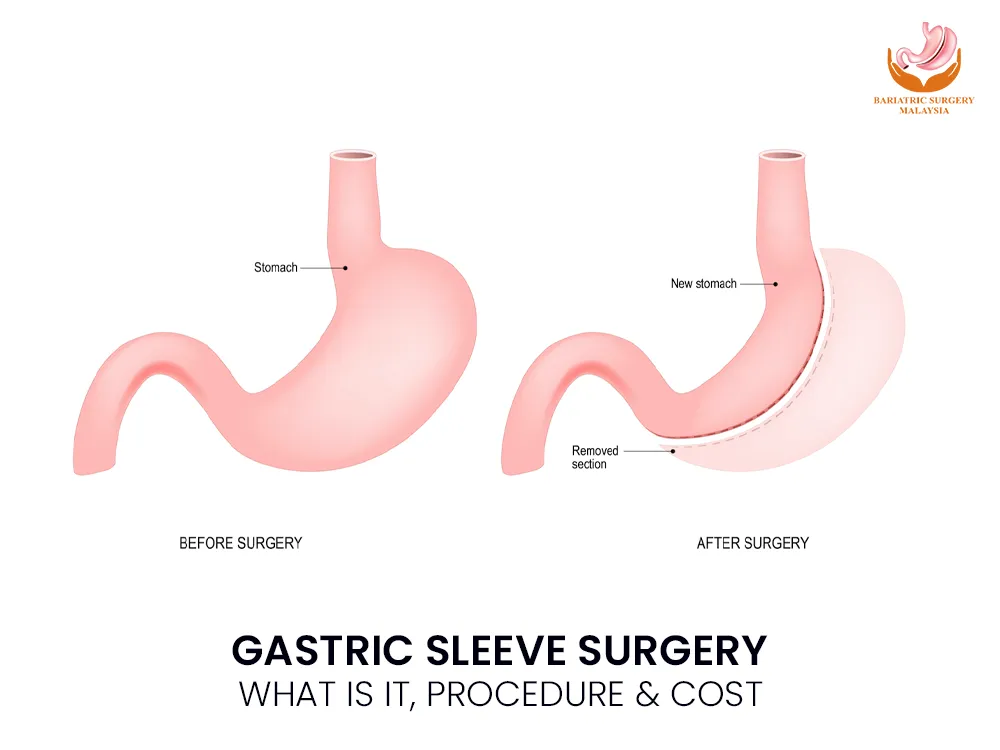Sleeve Surgery
Gastric Sleeve Surgery – Obesity is a serious health concern, with millions of people around the world struggling to manage their weight. While lifestyle changes, like diet and exercise, can help some individuals achieve weight loss, many others turn to medical interventions, including bariatric surgery. Among the various weight-loss surgeries available, gastric sleeve surgery (also known as sleeve gastrectomy) has gained significant popularity due to its effectiveness, fewer complications, and minimal recovery time.
What Is Gastric Sleeve Surgery?

Gastric sleeve surgery is a type of bariatric surgery aimed at helping people achieve significant weight loss. During this procedure, a large portion of the stomach is removed, leaving behind a small, tube-like structure that resembles a sleeve. This smaller stomach can hold significantly less food, reducing overall food intake and helping patients feel fuller with smaller portions.
Unlike other bariatric surgeries, gastric sleeve surgery doesn’t involve rerouting or bypassing any parts of the digestive system, making it a simpler and less invasive option compared to procedures like gastric bypass. It’s typically performed laparoscopically (using small incisions and a camera), which allows for a faster recovery time and less discomfort compared to traditional open surgery.
How Does Gastric Sleeve Surgery Work?
| Step | Procedure Description |
|---|---|
| Step 1: Pre-Surgery Consultation | Before the surgery, the patient meets with a bariatric surgeon for a thorough evaluation. This includes reviewing medical history, conducting physical exams, and discussing potential risks and benefits. The patient may also meet with a dietitian and psychologist. |
| Step 2: Anesthesia | On the day of surgery, the patient is given general anesthesia to ensure they are asleep and pain-free during the procedure. |
| Step 3: Laparoscopic Incisions | Small incisions are made in the abdomen, typically about 5-6 cm in length. A laparoscope (a thin tube with a camera) is inserted to view the inside of the abdomen. |
| Step 4: Stomach Removal | The surgeon removes approximately 80% of the stomach, leaving behind a small, tube-like section. This reduces the stomach’s capacity to hold food and helps control hunger. |
| Step 5: Closure of Incisions | After the stomach is reshaped, the small incisions are closed using sutures or surgical staples. |
| Step 6: Recovery and Observation | The patient is monitored closely for several hours to ensure there are no complications. Most patients stay in the hospital for 1-2 days for observation. |
| Step 7: Post-Operative Care | After discharge, the patient follows a specific post-operative care plan, which includes a liquid diet initially, then progressing to soft foods and eventually solid foods. The patient is encouraged to follow a healthy eating plan and engage in physical activity for long-term success. |
| Step 8: Follow-Up Appointments | The patient attends follow-up visits with the surgeon and dietitian to monitor weight loss, nutritional status, and overall health. These appointments are essential to ensure proper healing and progress. |
The primary goal of gastric sleeve surgery is to limit the amount of food a person can consume, ultimately helping them lose weight. By removing about 80% of the stomach, the procedure creates a small, sleeve-shaped stomach that is roughly the size and shape of a banana. This drastically reduces the capacity of the stomach, making it easier for individuals to feel full after consuming small portions of food.
But the surgery isn’t just about reducing stomach size—it also affects the hormones that regulate hunger. Specifically, gastric sleeve surgery reduces the secretion of ghrelin, the hormone responsible for stimulating appetite. This can help patients feel less hungry, making it easier to stick to a healthier eating plan.
What Does Recovery from Gastric Sleeve Surgery Look Like?
Recovery from gastric sleeve surgery is generally smooth, but it requires some time and commitment. Most patients are able to go home the day after surgery or within 48 hours, depending on their progress and any underlying health conditions. However, the recovery period is a gradual process that can take several weeks.
During the first few days after surgery, you will likely experience some discomfort, especially in the abdominal area. Some people also experience nausea, bloating, and fatigue. Your doctor will provide you with medications to help manage pain and prevent complications.
In the weeks following the surgery, you’ll need to follow a specific post-surgery diet that starts with liquids and gradually progresses to soft foods and eventually solid foods. This phased approach helps ensure that your stomach heals properly and prevents overloading your new stomach pouch.
The total recovery time can vary, but most patients return to normal activities within 4 to 6 weeks. It’s important to follow your surgeon’s instructions regarding diet, physical activity, and follow-up appointments to ensure proper healing and weight loss.
What Condition Is Gastric Sleeve Surgery Used to Treat?
Gastric sleeve surgery is primarily used to treat severe obesity, also known as morbid obesity. This condition is defined by a body mass index (BMI) of 40 or higher, or a BMI of 35 or higher with obesity-related health conditions like type 2 diabetes, hypertension, sleep apnea, or heart disease. For many people, lifestyle changes such as diet and exercise aren’t enough to achieve lasting weight loss, and gastric sleeve surgery becomes an essential tool.
In addition to treating obesity, gastric sleeve surgery can significantly improve or even resolve obesity-related health conditions. Studies have shown that many patients experience substantial improvements in blood sugar levels, cholesterol, and blood pressure following the surgery.
What Are the Benefits of Gastric Sleeve Surgery?
There are several key benefits to undergoing gastric sleeve surgery, beyond just weight loss. Here are a few of the most notable advantages:
1. Significant Weight Loss
The primary benefit of gastric sleeve surgery is significant, sustained weight loss. Many patients lose 50-70% of their excess weight within the first 12-18 months following surgery. Over time, weight loss tends to plateau, but individuals typically maintain a substantial loss for many years.
2. Improved Health and Quality of Life
One of the most profound benefits of gastric sleeve surgery is its ability to improve or eliminate obesity-related health conditions. This includes conditions like type 2 diabetes, hypertension, sleep apnea, and joint pain. Many patients also report improvements in mobility, self-esteem, and overall quality of life.
3. Minimal Recovery Time
Compared to other bariatric procedures, gastric sleeve surgery generally requires a shorter recovery time. Most patients can return to their normal routines within a few weeks, with less pain and fewer complications.
4. No Need for Foreign Objects or Re-routing
Unlike gastric bypass surgery, which involves rerouting the digestive system or inserting foreign objects like a gastric band, gastric sleeve surgery simply reduces the size of the stomach. This means there is less risk of complications like malabsorption or foreign object-related issues.
Is Gastric Sleeve Surgery Better Than Other Available Treatments?
When compared to other bariatric surgery options, gastric sleeve surgery offers several distinct advantages. For instance, gastric bypass surgery also helps with weight loss but involves more complex procedures like rerouting part of the intestines. This leads to a longer recovery time, higher risk of complications, and potentially more long-term lifestyle adjustments.
On the other hand, gastric banding (another weight-loss surgery) involves placing an adjustable band around the stomach to limit food intake. While this method can also lead to weight loss, it’s less effective than gastric sleeve surgery, and the band may need to be adjusted or removed over time.
Ultimately, the best treatment depends on the individual. Your healthcare team will consider factors like your BMI, overall health, weight loss goals, and medical history when recommending the best option for you.
What Are the Risks Associated with Gastric Sleeve Surgery?
As with any surgery, gastric sleeve surgery carries certain risks. Some of the most common risks include:
- Infection at the incision sites
- Blood clots or deep vein thrombosis (DVT)
- Leaks in the stomach, which can lead to infection or other complications
- Nutritional deficiencies, particularly in vitamins and minerals, due to reduced food intake and absorption
- Gastroesophageal reflux disease (GERD), which may be aggravated after surgery
- Gallstones, which can develop due to rapid weight loss
However, serious complications are rare, especially when surgery is performed by an experienced surgeon and after following proper post-operative care.
What Makes Yale Unique in Its Approach to Gastric Sleeve Surgery?
At Yale, we take a patient-centered approach to weight loss surgery. Our skilled bariatric surgeons are highly experienced in performing gastric sleeve surgery using the latest minimally invasive techniques. We also offer a comprehensive support system that includes dietitians, psychologists, and fitness experts to guide you through your weight loss journey.
Our team understands that weight loss surgery is not just about the procedure itself—it’s about the long-term lifestyle changes that lead to sustained results. That’s why we work closely with our patients, offering ongoing support before, during, and after surgery to help you achieve your weight loss goals and improve your overall health.
Final Thoughts
Gastric sleeve surgery can be life-changing for individuals struggling with obesity and related health conditions. With significant benefits such as improved health, sustained weight loss, and minimal recovery time, it’s one of the most popular and effective weight-loss surgeries available today. If you’re considering gastric sleeve surgery, it’s crucial to consult with a trusted, experienced surgical team to discuss whether this option is right for you.


